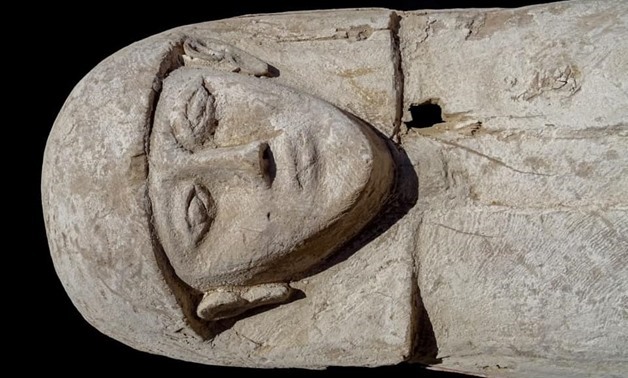
File - A mummy dating back to the 17th dynasty uncovered in Draa Abul Naga necropolis on Luxor’s West Bank.
CAIRO - 1 May 2020: Daily Mail highlighted the uncover of an anthropoid coffin containing a mummy dating back to the 17th dynasty in Draa Abul Naga necropolis on Luxor’s West Bank on April 24.
The discovery was made by Spanish-Egyptian archaeological mission headed by José Galán.
The newly discovered coffin measures 1.75 by 0.33m, and was carved in wood cut from a sycamore tree trunk, covered with a whitewash and painted in red. The coffin was placed on the ground horizontally.
The mummy which was found in a bad conservation condition is of a 15- or 16-year-old girl resting on her right side inside the coffin.
The girl mummy is wearing two spiral shaped earrings in one of her ears. The two earrings are covered with a thin metal leaf.
The newly uncovered mummy is wearing two rings, one made of bone and the other with a blue glass bead set on a metal base and tied with string.
Around the mummy chest there are four necklaces tied together with a faience clip. The first necklace is 70cm long, made from rounded faience beads and alternating dark and light blue.
While the second one is 62cm long, and made of green faience and glass beads.
The third necklace measures 61cm and is made of 74 pieces, combining beads of amethyst, carnelian, amber, blue glass and quartz. The most beautiful necklace has two scarabs, one depicting the falcon god Horus, and five faience amulets.
The fourth necklace is made of several strings of faience beads tied together at both ends by a ring combining all the strings.
The mission unearthed as well a mud-brick offering chapel and a pile of mixed materials from funerary equipment.
The director of the mission announced that these discoveries were found during excavation performed at the area located in front of the open courtyard of Djehuty’s tomb (TT 11).
A small coffin made of mud was also found at the opposite side of the mud-brick chapel. It is still closed and tied together with string.
Inside the coffin there was a wooden ushabti wrapped in four linen bandages. The ushabti figurine and one of the linen bandages have hieratic text on them revealing the identity of their owner ‘’the Osiris, Djehuty’’ who lived in the 17th dynasty (c.1600 BCE).
A pair of leather sandals were found together with a pair of leather balls tied together with string, in the same area, but inside a funerary shaft.
The newly uncovered sandals which are dating back to the 17th dynasty are dyed in a red colour, and engraved with different motifs depicting god Bes, goddess Taweret, a pair of cats, an ibex and a rosette. The 3,600 years old sandals were found in a good state of preservation.
The sandals decoration and size shows that it is probably belonged to a woman, and also the balls, were used by a woman for sport or as part of a dancing choreography, according to daily life depictions in Beni Hassan tombs of the 12th dynasty.


Comments
Leave a Comment